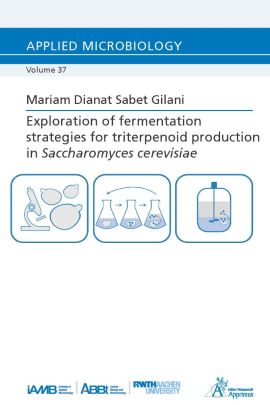Triterpenoids are plant secondary metabolites, which have been used in traditional medicine and show potential for application in the pharmaceutical, cosmetic, and food industries. The application of microbial factories for the production of triterpenoids is a promising alternative to the existing low-yield, complex, and environmentally-affecting processes.
The focus of this work is gaining insights into cell performance for an optimal process design. The heterologous production of triterpenoids in Saccharomyces cerevisiae is investigated on the example of lupane-type pentacyclic triterpenoids.
First, a non-invasive monitoring of triterpenoid synthesis by non-linear microscopy was developed. A proof-of-principle study showed that the combination of coherent anti-Stokes Raman scattering (CARS) and second-harmonic-generation (SHG) microscopy techniques can be used for monitoring of triterpenoid synthesis in yeast cells. The SHG signal in triterpenoid-producing strains was higher than in a reference strain. In growing cultures, both CARS and SHG signals changed over time, enabling new insights into the dynamics of triterpenoid production and storage by recombinant yeast.
Next, a method for extraction of triterpenoids from living yeast cells was evaluated, to address the challenge of intracellular product accumulation. A solvent screening followed by solvent testing on yeast physiology and viability suggested isopropyl myristate (IPM) as a suitable solvent. In experiments, where IPM was added at the end of the batch, a significantly higher triterpenoid production was observed. Additionally, also the effect of cyclodextrins on product secretion from the cell was shown to be effective. The developed extraction method was applied in fed-batch experiments in a bioreactor, showing the possibility of in situ extraction of triterpenoids without affecting cell viability.
Next, glucose as carbon source for triterpenoid synthesis was revisited. The productivities of three triterpenoid-producing strains on glucose were compared in glucose-limited fed-batch cultivations in shake flask.
This work contributes to novel analytical ideas, a method to overcome limitations caused by intracellular product accumulation, and for simplification of the downstream process, showing the endless opportunities for application of S. cerevisiae as a microbial cell factory.
| Autor | Dianat Sabet Gilani, Mariam |
|---|---|
| Gewicht | 0.221 kg |
| Erscheinungsdatum | 08.01.2025 |
Eigene Bewertung schreiben
Institut für Angewandte Mikrobiologie (iAMB)
Exploration of fermentation strategies for triterpenoid production in Saccharomyces cerevisiae
ISBN: 978-3-98555-246-7
Lieferzeit: 2-3 Tage
54,00 €
inkl. 7% MwSt.
Kurzbeschreibung
Triterpenoids are plant secondary metabolites with wide application fields. Their production in microbial cell factories is a more advantageous alternative to the existing processes. This work focusses on gaining insights into cell performance for an optimal process design. For this, a novel analytical method and a strategy to overcome limitations caused by intracellular product accumulation, and for simplification of the downstream process were evaluated.
Auf Lager

